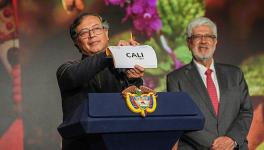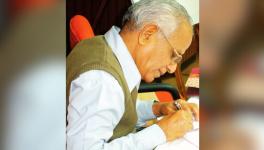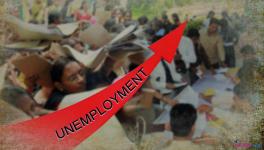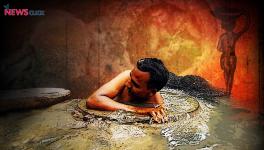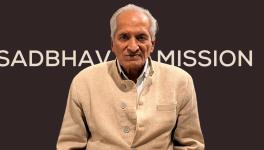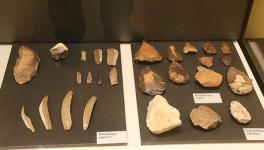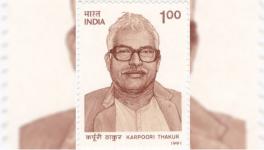The Tragic Killing of Colombia’s Sports Hero, Patrón

Patrón cortando caña (Patrón cuts the cane), Colombia, 2015. Photo by Pablo Fierro.
Not much, apart from football, unites the Colombian people. If a 2014 Interior Ministry survey called “The Power of Football” is to be believed, then 94% of the Colombian population say that football is either important or very important. Patrocinio Bonilla—called Patrón—was on the side of those who believed that football was very important, indeed essential. Patrón was murdered on August 11, 2020.
Patrón lived in Chocó in northwestern Colombia, where 96% of the people identify as Afro-Colombian or as part of the Emberá Indigenous community. Chocó is treated as a backwater of the country, with no real infrastructure in the province’s expanse and little social policy to enhance the lives of its population.
“From a very young age,” a friend of Patrón’s told us, “he wanted to be a professional football player.” He went to Medellín, where he tried his luck with Atlético Nacional, even though he was a fan of América de Cali (a team loved by Afro-Colombians). His poverty prevented him from being able to stay in Medellín to train, so he returned home to Pie de Pató in Chocó.
Patrón organised a football tournament in the area. He told his friend Germán Bedoya—a founder of the national agrarian movement (Coordinador Nacional Agrario, or CNA)—that if he could keep the young people occupied with football, then they would not be so easily recruited into the narco-trafficking and paramilitary organizations that preyed on these communities. The narco-traffickers needed the land to grow cocaine, and they needed the young people as their disposable employees. This is what Patrón tried to prevent through football.
Assassination
On August 11, Patrón went into the hills to chop wood with about two dozen other people from his community. In that region, one of his friends told us, “there is a custom to cut wood at certain times of the year; the wood is cut and sawed and then brought down the Baudó River to Puerto Meluk or Puerto Pizarro.” On that day, Patrón and the others were confronted by armed members of the paramilitary groups that terrorized the area. The armed men interrogated Patrón and his friends, and then released them all except Patrón. “Minutes later,” Patrón’s friend told us, the group Patrón had been with “heard shots, and they knew that they [the men] had assassinated Patrón. They waited for the assassins to leave, went back, and found him dead with his face in the earth.”
Patrón’s body was brought back to his community in Alto Baudó, where it was washed and dressed in white sheets; rituals of burial rooted in Afro-Colombian traditions were then performed. When his mother, sisters, cousins, and son tried to come for the ceremony, they were prevented by the same paramilitary groups (who did this within sight of the army and the police). Eventually, only his mother, his son, and one sister were able to get through to attend the ceremony.
Displacement of the People
In early August, in addition to Patrón, nine young people were assassinated in Samaniego, five children were tortured and killed in Cali, two children were killed in the border area of Cauca and Nariño, and two Indigenous people—one of them a journalist—were assassinated in Cauca by the army. This is part of a spate of murders going on in recent years. Between November 2016 and August 19, 2020, 974 social leaders and human rights defenders were assassinated in Colombia (185 in 2020 alone), according to live updates from the Institute of Development and Peace Studies (Indepaz) following their release of a July 15 report they prepared with two other Colombian activist organisations. In Patrón’s region of Alto Baudó, between December 2019 and March 2020, about 17 people were assassinated.
These killings are not random. They are part of an assault on the Afro-Colombian and Indigenous communities in northwestern Colombia, particularly against anyone who resists the power of the narco-traffickers and their paramilitaries; they are also an attack on the Colombian left, since people like Patrón are affiliated with groups such as CNA and the Congreso de Los Pueblos. Since the 1990s, these groups have evicted large numbers of subsistence farmers and killed many political leaders. In the last two decades, paramilitary groups have displaced thousands of people who lived in Chocó, particularly the Alto Baudó community. Many of them have not been able to return home. These displacements continue, despite the pandemic.
Building a Fence
In 2009, the CNA arrived in Alto Baudó and other parts of Chocó to strengthen the communities that had been hit hard by the narco-traffickers and their paramilitaries. As part of its work, the CNA introduced agro-ecological production techniques, often built on older Afro-Colombian agricultural traditions, and helped both the Afro-Colombian and the Indigenous communities defend their rights to the land.
During their work with CNA, the local communities built an organization called Kinchas; the word means a barrier or a fence, a protection built to prevent animals from running riot through the crops. Kinchas was formed first to protest against the aerial spraying of glyphosate, a dangerous chemical, on crops. In 2015, the government of Colombia stopped using glyphosate after studies showed it was dangerous to people. But in March 2020, Colombian President Iván Duque told U.S. President Donald Trump he would resume the use of glyphosate as an herbicide on crops of coca as a weapon against cocaine production. The resumption of glyphosate use, not only on coca crops but other kinds too, would threaten to, once again, make the area uninhabitable for the Afro-Colombians and the Indigenous communities.
Patrón was a founder of Kinchas. A comrade of his told us that “Kinchas was the barrier against the glyphosate. We demarcated the food-growing zones with huge tall yellow and green banners so that the pilots of the small planes would know not to spray there.” Kinchas was a barrier against the glyphosate and other toxins; people like Patrón built it to protect the growing of subsistence crops using agro-ecological techniques. The work of Kinchas, we were told, “is a political struggle to raise awareness and to fight for the rights of the people to their land.”
The Alliances of Death
“In Colombia we continue to confront the deepening of state terrorism,” Ernesto Roa, the president of the CNA, told us. “Far from looking for solutions to the structural problems in the country, the state continues to turn over the land to transnational companies,” he said. There is an “alliance of death,” Roa said, a close link between the army, the police, and the paramilitaries of the narco-traffickers. It is concern about this “alliance of death” that motivated the Supreme Court to sentence Colombia’s former President Álvaro Uribe to house arrest on August 4; protests on behalf of Uribe and favourable statements by the current President Iván Duque—and close U.S. ally—suggest that even the highest court has little power to seek justice for the acts committed by the “alliance of death.”
The province of Chocó is one of the flashpoints for this “alliance of death.” Patrón, who loved to dance and drink viche (distilled aguardiente), had received several death threats prior to August 11; his work in building peace had rattled the paramilitaries. Germán Bedoya told us that this scared Patrón, and so Patrón “decided to lower his profile, to continue to encourage football but to lower his political profile.” Nonetheless, he continued to be active in the community council and in the local government in Alto Baudó. Patrón was a natural leader of his community, someone who could not retreat from the demands made by his people. It is this work that likely painted a target on Patrón’s back for the paramilitary groups and led to his death.
Tenderness and His Smile
When Germán Bedoya last spoke to Patrón, the conversation drifted into football. Patrón told Bedoya that he wanted to create a talent school for children just like himself who harboured ambitions for a professional football career. Bedoya remembers his friend and comrade for his love of his land and his roots, for his love of the Baudó River and for Chocó, for his love of hunting and being connected to Afro-Colombian culture. Patrón leaves behind, Bedoya told us, “the lesson of tenderness, the lesson of his smile, and the lesson of his consistency in the struggle.”
Vijay Prashad is a writing fellow and chief correspondent at Globetrotter, a project of the Independent Media Institute. He is the chief editor of LeftWord Books and the director of Tricontinental: Institute for Social Research.
Zoe PC is a journalist with Peoples Dispatch and reports on people’s movements in Latin America.
This article was produced by Globetrotter, a project of the Independent Media Institute.
Get the latest reports & analysis with people's perspective on Protests, movements & deep analytical videos, discussions of the current affairs in your Telegram app. Subscribe to NewsClick's Telegram channel & get Real-Time updates on stories, as they get published on our website.










